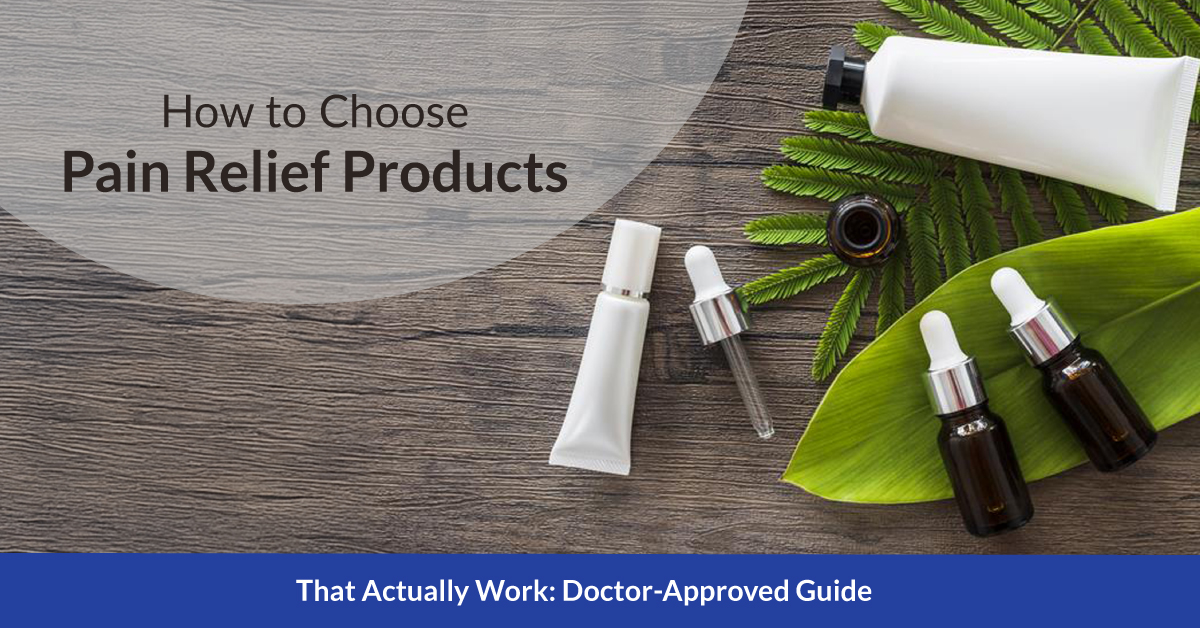

Oct 10, 2025

Pain can strike anyone at any age, though elderly people face a higher risk. Many of us feel overwhelmed while choosing pain relief products. We often stand confused before shelves stocked with countless options, wondering which one will actually help our specific discomfort.
Each type of pain needs its own solution. The wrong product simply won't give you relief. Most people focus on brand names but miss the crucial step of matching remedies to their specific pain type. Quick-absorbing gels serve people who stay active, while heat therapy helps relax tight muscles and soothes joint pain. Pain relief products come in several forms and sizes - from Moov's 15-80 gm gels to Volini's wide range of sprays and gels.
This piece offers a doctor-approved approach to help you pick chronic pain relief products that deliver real results. You'll learn to identify your pain type, discover various relief options, and get practical tips to select a pain reliever that matches your specific needs.
The right pain relief product depends on understanding your specific type of pain. Different kinds of pain need different treatments, and knowing exactly what hurts helps you pick the treatment that will work best.
Pain duration falls into two main categories: acute and chronic. Sudden pain that lasts a few days to six weeks is acute pain, while pain that stays around for more than three months becomes chronic. A sprained ankle might hurt badly but usually gets better in seven to ten days. Arthritis pain, however, can stick around indefinitely.
The pain's origin makes a big difference in treatment choices. People with inflammatory pain from conditions like arthritis respond well to anti-inflammatory drugs. Your muscles might hurt from a workout, physical strain, or an infection. Joint pain often comes from osteoarthritis, which affects more than half of all people aged 65 and older. Bad posture creates neck and back pain - a problem that 70% of remote workers now face.
The severity of your pain guides treatment options too. Over-the-counter medicines usually handle mild to moderate pain, but severe pain might need prescription medications.
Your pain might come with other symptoms like swelling, stiffness, limited movement, or nerve-related issues such as numbness and tingling. These signs point you toward the best pain relief approach for your situation.
The market offers many options to help with different types of pain. Most people start with oral medications like acetaminophen (Tylenol) that blocks pain signals in the brain. NSAIDs (aspirin, ibuprofen, and naproxen) work by reducing inflammation. Naproxen stands out as one of the strongest over-the-counter anti-inflammatory options available.
Topical treatments target pain directly without affecting your whole body. These include:
Essential oils have become a popular choice to ease muscle discomfort. Research shows that topical pain relievers can cut pain levels by up to 50%. Peppermint oil provides cooling relief, while ginger oil creates warming effects. Arnica oil helps reduce inflammation.
Pain relief comes in many forms - tablets, sprays, patches, gels, creams, and even suppositories. Sprays like Omnigel that contain diclofenac help you recover from inflammation twice as fast. This makes them a great choice if you need quick relief.
Your choice of pain relief product should match your specific type of discomfort. Start by thinking over the active ingredients based on your pain type. Anti-inflammatory ingredients like diclofenac or methyl salicylate work best for inflammatory conditions like arthritis. Products with menthol or camphor are better for muscle soreness because they create cooling sensations that block pain signals.
The product format makes a big difference. You can get quick relief from creams and gels that work within 30 minutes to an hour. Sprays let you apply the medicine without touching the area - perfect for spots that are hard to reach. Patches give you longer-lasting relief over time.
A patch test is crucial when you try a new product, especially when you have sensitive skin. These products should never go on broken skin, burns, or rashes. Make sure you wash your hands well after applying to avoid irritating sensitive areas like your eyes.
Read labels carefully to prevent overdosing, especially when you have acetaminophen-containing products. Pregnant women need to check with their doctor before taking any pain reliever since NSAIDs aren't safe during the third trimester.
Your pain needs medical attention if it lasts beyond a few weeks, gets worse, or comes with numbness, weakness, or fever. Over-the-counter options should support but not replace professional medical care for chronic conditions.
Picking the right pain relief gel is actually quite simple. In this piece, we've looked at how your specific pain type forms the foundations of treatment that works. The right solution matches your unique discomfort, whether you're dealing with acute muscle soreness or chronic joint inflammation.
The variety of products available today gives you plenty of options to deal with pain. Different products come with their own benefits - creams work for targeted relief, sprays can reach tricky spots, and patches provide comfort that lasts longer.
Your safety comes first when picking pain relief products. Read labels with care and test new topical treatments on a small area first. Clean hands are essential after you apply these products. Over-the-counter remedies can help manage many painful conditions. They work best as part of a complete approach to wellness.
The right product can make your life substantially better by cutting down discomfort and keeping you active. But you should see a doctor if pain persists or gets worse. These products are helpful tools rather than complete fixes for chronic conditions.
This guide gives you the knowledge to pick pain relief options that suit your needs. Pain management becomes easier when you take it step by step. Start by identifying your pain type, then pick ingredients and forms that target your specific discomfort.

‘Sign up’ for our newsletter to unlock exclusive updates, special offers, and wellness tips. Be the first to discover new products and promotions. Join us on the path to an active and pain-free lifestyle !